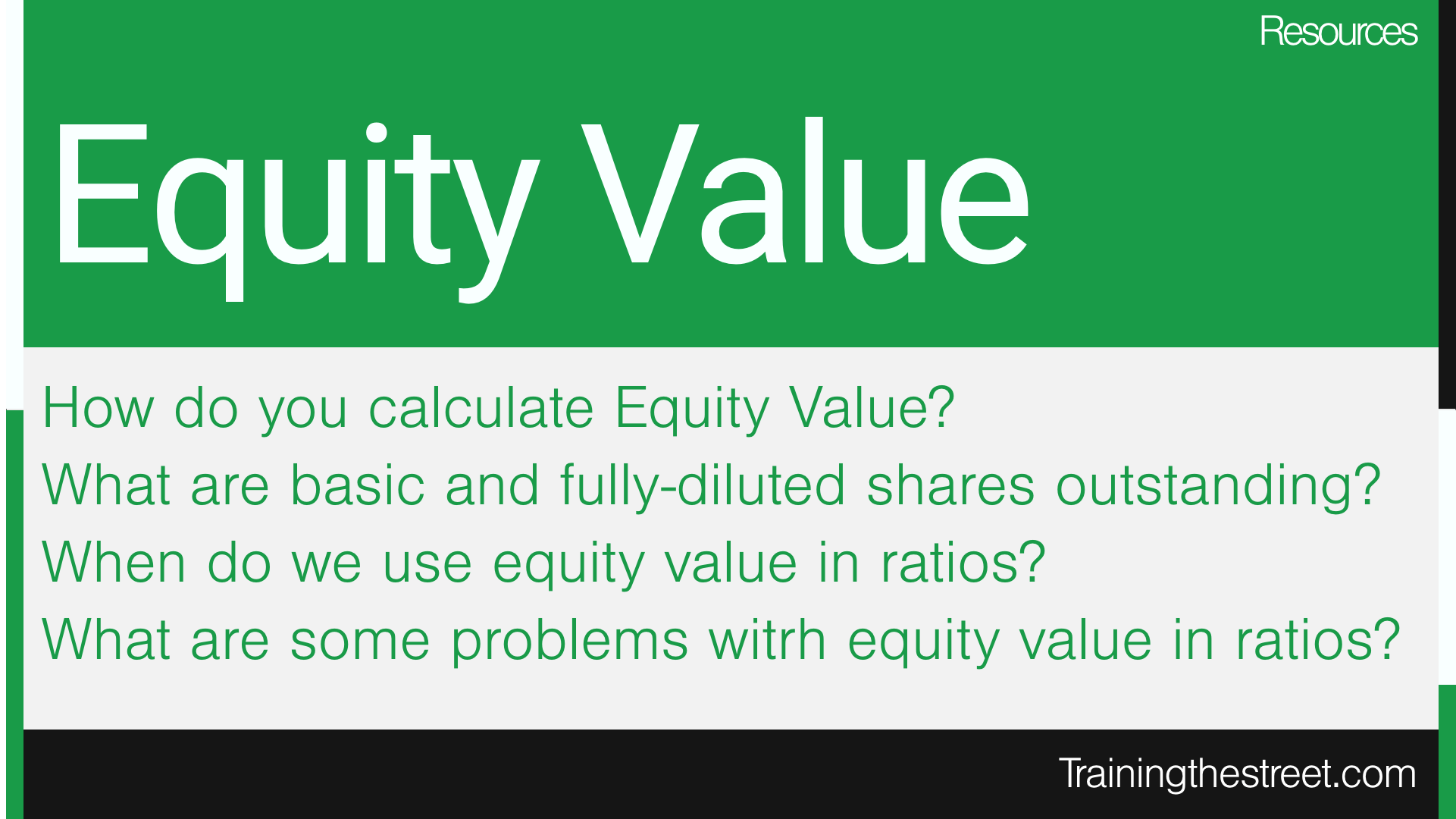In this article, we’ll explore the topic of Equity Value, basic and diluted shares outstanding, and key ratios related to equity value.
Table of Contents
How do you calculate equity value?
What are basic shares outstanding?
What are fully diluted shares outstanding?
When do we use Equity Values in ratios?
What are some problems with Equity Value in ratios?
How do you calculate equity value?
Equity value typically refers to the market value of a company’s common equity. If the company is public, the equity value can easily be calculated by multiplying the number of diluted shares outstanding by the latest price per common share of the company. If the company is not public, other valuation methods such as comparables or discounted cash flows can be used.
What are basic shares outstanding?
In determining the number of shares used in the equity value calculation, we start with the basic number of shares outstanding. Basic shares represent number of shares that are issued and outstanding as of the reporting or current date. It does not include shares that may be issued at a future date as a result of dilutive instruments such as options. The basic number can be found in the company’s most recent financial statements. The number may appear on the balance sheet or in the footnote for shareholders equity. For U.S. companies, the basic number of shares outstanding will also appear on the first page of the 10K and 10Q, although this number will be as of the date of the filing of the document, as opposed to the date of the latest financial statements included.
If some time has passed since the most recent filing was posted, it will be necessary to check for changes in the basic shares outstanding since the filing. Press releases that have been issued since the filing date should be checked for stock issuances or share buybacks which may need to get added to or subtracted from the number of basic shares outstanding. Importantly, if an adjustment is made to the basic share count to reflect a subsequent event, it’s important to adjust the company’s balance sheet for offsetting entries – for example, if a company issued shares after the latest filing date, the share count would increase but the cash balance would need to increase as well to reflect the proceeds of the offering.
It is also very important to check for stock splits (or stock consolidations) that may have occurred after the latest filing.
What are fully diluted shares outstanding?
The fully diluted shares outstanding includes basic shares outstanding, plus shares that would be outstanding if all the dilutive equity instruments were exercised / converted. Options and warrants are equity instruments that give the holder the right to purchase shares in the company at a specified price (exercise price) for a given period of time. If the exercise price is below the current share price, then the option or warrant is said to be in-the-money. All in-the-money options or warrants are dilutive. Other dilutive instruments could include debt or preferred shares convertible into common stock, as well as Restricted Stock Units, Performance Stock Units and Director Stock Units issued to employees and directors.
When do we use Equity Values in ratios?
Equity values are often used in ratios by the investment community. For instance, you may evaluate a company based on its ratio of price-to-earnings (P/E) or price-to-book value (P/BV). In these examples, we are comparing the price of the company’s equity to some measure attributable to equity holders in the denominator. Both the earnings and the book value are attributable to equity holders (denominator) so it is appropriate to compare these to the equity value in the numerator. This consistency between the numerator and denominator is crucial.
Investors may compare companies based on a measure of price-to-sales. However, this is not appropriate since the stock price measures the value of the equity, but the sales are attributable to all capital providers. A more appropriate measure would be to consider the company’s enterprise value-to-sales ratio, in which all capital providers are represented in the numerator and the denominator.
What are some problems with Equity Value in ratios?
Problems can arise when comparing companies using equity value. With a price-to-earnings ratio, significant differences in the earnings can arise due to different depreciation methods, capital structures and interest rates for each company. For instance, a company using a double-declining balance method of depreciation will have different depreciation values than a company using a straight-line depreciation method. Also, companies may have different capital structures. A company with more debt in its capital structure may have higher interest expense and less earnings. Similar companies may also operate in different jurisdictions which could lead to significant tax differences resulting in discrepancies in its after-tax earnings. These are some of the reasons why many investment professionals use enterprise value instead of equity value to measure and compare various companies.

